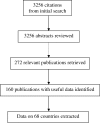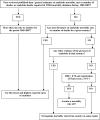The global burden of snakebite: a literature analysis and modelling based on regional estimates of envenoming and deaths
- PMID: 18986210
- PMCID: PMC2577696
- DOI: 10.1371/journal.pmed.0050218
The global burden of snakebite: a literature analysis and modelling based on regional estimates of envenoming and deaths
Abstract
Background: Envenoming resulting from snakebites is an important public health problem in many tropical and subtropical countries. Few attempts have been made to quantify the burden, and recent estimates all suffer from the lack of an objective and reproducible methodology. In an attempt to provide an accurate, up-to-date estimate of the scale of the global problem, we developed a new method to estimate the disease burden due to snakebites.
Methods and findings: The global estimates were based on regional estimates that were, in turn, derived from data available for countries within a defined region. Three main strategies were used to obtain primary data: electronic searching for publications on snakebite, extraction of relevant country-specific mortality data from databases maintained by United Nations organizations, and identification of grey literature by discussion with key informants. Countries were grouped into 21 distinct geographic regions that are as epidemiologically homogenous as possible, in line with the Global Burden of Disease 2005 study (Global Burden Project of the World Bank). Incidence rates for envenoming were extracted from publications and used to estimate the number of envenomings for individual countries; if no data were available for a particular country, the lowest incidence rate within a neighbouring country was used. Where death registration data were reliable, reported deaths from snakebite were used; in other countries, deaths were estimated on the basis of observed mortality rates and the at-risk population. We estimate that, globally, at least 421,000 envenomings and 20,000 deaths occur each year due to snakebite. These figures may be as high as 1,841,000 envenomings and 94,000 deaths. Based on the fact that envenoming occurs in about one in every four snakebites, between 1.2 million and 5.5 million snakebites could occur annually.
Conclusions: Snakebites cause considerable morbidity and mortality worldwide. The highest burden exists in South Asia, Southeast Asia, and sub-Saharan Africa.
Conflict of interest statement
Figures







Comment in
-
Estimating the global burden of snakebite can help to improve management.PLoS Med. 2008 Nov 4;5(11):e221. doi: 10.1371/journal.pmed.0050221. PLoS Med. 2008. PMID: 18986211 Free PMC article.
References
-
- World Health Organization. A neglected public health issue: Report of a consultative meeting. Geneva: WHO; 2007. Rabies and envenomings. Available: http://www.who.int/bloodproducts/animal_sera/Rabies.pdf. Accessed 9 October 2008.
-
- Hansdak SG, Lallar KS, Pokharel P, Shyangwa P, Karki P, et al. A clinico-epidemiological study of snake bite in Nepal. Trop Doct. 1998;28:223–226. - PubMed
-
- White J. Bites and stings from venomous animals: A global overview. Ther Drug Monit. 2000;22:65–68. - PubMed
-
- Gutierrez JM, Theakston DR, Warrell DA. Confronting the neglected problem of snake bite envenoming: the need for a global partnership. PLoS Med. 2006;3:e150. doi: 10.1371/journal.pmed.0030150. - DOI - PMC - PubMed
Publication types
MeSH terms
LinkOut - more resources
Full Text Sources
Other Literature Sources
Medical

